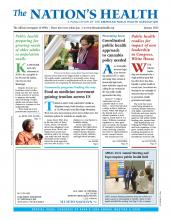
Johanna Franz shops at the Veggie Mobile in Albany in 2016. The mobile market, supported by a local health center, brings affordable local produce to neighborhoods with low access. More communities are recognizing the link between food and health.
Photo by Lori Van Buren, courtesy Albany Times Union/Getty Images
There is only one grocery store in Alleghany County, North Carolina, a rural area of 11,000 people in the Blue Ridge Mountains. There are some mom-and-pop stores and a dollar store, but nutritious options for residents are usually slim.
Lanae Hood, PhD, lives in the tiny town of Piney Creek, about a 30-minute drive from Alleghany’s sole grocery store. Hood, who studies food access and nutrition policy for a living, can make the trek. But for thousands in the county — where the food insecurity rate was 18% in 2022 — the distance is a real barrier to healthier eating.
At the same time, Alleghany has higher-than-average rates of nutrition-related chronic diseases, such as obesity, diabetes and high blood pressure, said Hood, a policy associate at the Center for Science in the Public Interest. Nearly a fifth of county residents lack health insurance.

Community health worker Cody Hatcher, left, talks with cancer patient Curtis Adams in 2023 at a food “farmacy” located at Harris Health Lyndon B. Johnson General Hospital. The food prescription program helps patients access healthy foods.
Photo by Jon Shaple, courtesy Houston Chronicle/Getty Images
“We assume people aren’t interested in eating healthy, and that’s just not true,” Hood told The Nation’s Health. “For us, it’s mostly an access issue.”
That gap is the focus of a growing nationwide movement to improve health outcomes and narrow disease disparities by expanding access to nutritious foods. At the federal level, the approach is called Food is Medicine and encompasses a variety of multi-sector strategies, from issuing produce prescriptions in doctors’ offices to partnering with local farms to using Medicaid to enhance food access for at-risk patients.
“Food is Medicine is really about changing systems of care,” said Rachel Fisher, MPH, MS, RDN, co-lead of the federal Food is Medicine initiative at the U.S. Office of Disease Prevention and Health Promotion. “That’s a really important difference in how this effort is evolving — it’s about systems that support people.”
The Food is Medicine initiative launched in 2023 and is working to advance interventions that promote and enable access to healthy food as a strategy for reducing chronic disease. Research shows there is an association between poor health and food insecurity.
For example, a 2017 report from the U.S. Department of Agriculture found a “strong correlation” between food security and chronic disease among working-age adults living at or below 200% of the federal poverty level. The study showed low food security is linked to a higher probability of a range of chronic conditions, including heart disease, hypertension, stroke and cancer.
In the U.S., 60% of adults have a diet-related chronic disease, according to ODPHP. And more than 47 million people lived in food-insecure households in 2023, USDA says.
Erin McDonald, PhD, MPP, co-lead of Food of Medicine at ODPHP, said the initiative is promising because it hones in on clear partnership opportunities between health care, community-based groups, local growers and retailers. At the national level, partners such as Instacart and Feeding America are already working with the U.S. Department of Health and Human Services to scale up the food access strategy.
One ideal way to sustain food-as-medicine programs and broaden their reach is to get payers, such as private insurers and Medicaid, to cover the intervention. McDonald said 10 states are currently approved to incorporate Food is Medicine strategies into their Medicaid programs.
In North Carolina, for instance, a Medicaid demonstration project covered patients’ health-related social needs — such as food, housing and transportation — with the aim of improving health outcomes. An evaluation found food was the most common social need. Overall, the project reduced emergency department visits and inpatient hospitalizations.
“One thing that has been really powerful to us…is how much energy there is around building solutions that support each other,” McDonald said.
In Austin, Texas, a food access program at a local hospital, Ascension Seton, is supporting new moms and area farmers.
The program, Food is the Best Medicine, screens postpartum patients for food insecurity before discharge and offers eligible patients a $100 grocery voucher or eight weeks of home-delivered meals and produce from a local farm share.

Photo by Frazao Studio Latino, iStockphoto
Since it began in September 2023, organizers have made almost 1,500 deliveries and distributed more than 10,700 pounds of produce, according to Christopher Reyes, an MPH-MPAff student at the University of Texas Health Science Center who presented on the hospital program at APHA’s 2024 Annual Meeting and expo in October.
Feedback suggests the effort, which is supported with philanthropic funds, is working, he said.
Participants have reported improved food security and more fruit and vegetable consumption. Positive screenings for depression also declined among the new moms, Reyes said, especially for those paired with a community health worker.
“We’re hearing that it relieved some financial stress,” Reyes said.
The Indiana Department of Health is scaling up its Food is Medicine program, which focuses on integrating food and nutrition into clinical health care delivery. Naima Gardner, MPH, director of the department’s Division of Nutrition and Physical Activity, said the program is a departure for the agency, which typically focuses on community-based efforts.
With the support of a federal health disparities grant, the department recently launched two Food is Medicine pilots: Produce Rx and Double Up Indiana. In the produce program, health providers offer patients with eligible chronic conditions a voucher for fruits and veggies from a local market or retailer, as well as nutrition education.
Gardner said data show the Produce Rx pilot had a positive impact on people’s food security and health, including lowering blood-sugar levels.
“The (Food is Medicine) framework really positions food and nutrition as a critical component of holistic health care,” Gardner said. “That’s what makes it different from other food systems-based work.”
Double Up Indiana gives residents receiving Supplemental Nutrition Assistance Program benefits a voucher that matches up to $20 in produce purchases. In addition to promoting healthy eating, Gardner said the pilot directed about $250,000 back into local economies in 2022-2023.
Back in Alleghany County, North Carolina, Hood used her organizing experience to help fill the local nutrition gap.
In 2023, she and partners launched Appetite for Abundance, a grant-funded collaboration between a local church, the Allegheny Wellness Coalition and Blue Ridge Women in Agriculture, where Hood serves as a board member. The program provides 50 free bags of locally purchased farm produce once a month to residents. The bags are mostly fruits and vegetables, but also include fresh bread, eggs and meat, and nutrition education materials.
Survey results, which Hood presented at APHA’s Annual Meeting in Minneapolis, show the program is changing eating habits and relieving food insecurities. Eighty-six percent of participants said their families were consuming more produce, and 88% said it helped them “feel less stressed” about affording groceries.
Local farms also are part of Dartmouth Health’s Food is Medicine program in New Hampshire, which screens perinatal patients for food insecurity and offers on-site food bags and healthy food prescriptions.
Chelsey Canavan, MSPH, manager of Dartmouth Health’s Center for Advancing Rural Health Equity, said the program leans heavily on community partners. Between July 2022 and January 2024, it provided healthy food to about 300 patients before and after they gave birth, many of them in rural areas.
“It’s a need in our community and we have a responsibility to respond,” she said.

Photo by Aaron Amat, courtesy iStockphoto
For more, visit https://odphp.health.gov/foodismedicine.
- Copyright The Nation’s Health, American Public Health Association









